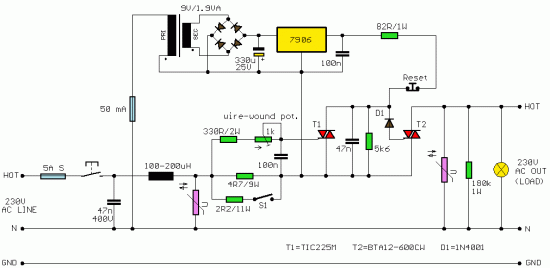Fast Electronic Fuse
Description:
A fast electronic fuse designed to operate on 230V AC with an adjustable trip current.
Notes:
When the current through the load exceeds a level determined by the position of the wiper on the 1k wire-wound pot, this circuit cuts off the load immediately. If S1 is open, the range is approximately 300-650 mA, and 0.8-2A when it is closed.
The key variable in the operation of the fuse is the voltage drop across the power resistor(s) which are connected in series with the load. This voltage drop is directly proportional to the current the load draws. When this current is low, the voltage across the resistors is also small and cannot trigger T1. At the same time the gate of T2 is fed from a little power supply built around a negative voltage regulator. T2 is conducting and the load is on.
If the current through the load then gets too high, so that the voltage created across the resistor(s) can trigger the gate of T1 through the 330R resistor and the pot: T1 starts to conduct, swiftly taking away all the current from the gate of T2. The voltage drop across T1 (MT1-MT2) will then be only 0.7 V and T2 will be firmly off. T1 stays this way all until the momentary (normally closed, "push-to-break") Reset push-button is pressed: this causes the current through T1 to drop below the hold level and forces this triac to turn off. Releasing the Reset button re-enables the current flow to and through the gate of T2, switching it on.
T1 must be a TIC225M, as this particular type has a very low trigger current. T2 is a snubberless BTA12-600CW which cannot be replaced with a 'normal' triac, but maybe with a BTA12-600BW which also can be used without a snubber circuit, but has a little less sensitive gate (not a problem in this design). If the gates of snubberless triacs are DC-controlled and they are switching AC, the DC to control the gates MUST be negative - flowing from the gate, hence the negative voltage regulator. (Snubberless is in fact a registered trade mark belonging to ST.)
The output AC voltage will be 1-5 volts below the input level, depending on the load. Varistors are 250V AC. Pay attention to the "reverse" polarities of the electrolytic capacitor and the diodes before the 7906.
DANGER! This circuit connects directly to 220-230V AC which can be lethal! Please do not attempt to build any of the circuits/projects unless you have the expertise, skill and concentration that will help you avoid an injury. Please see Disclaimer on this site.

